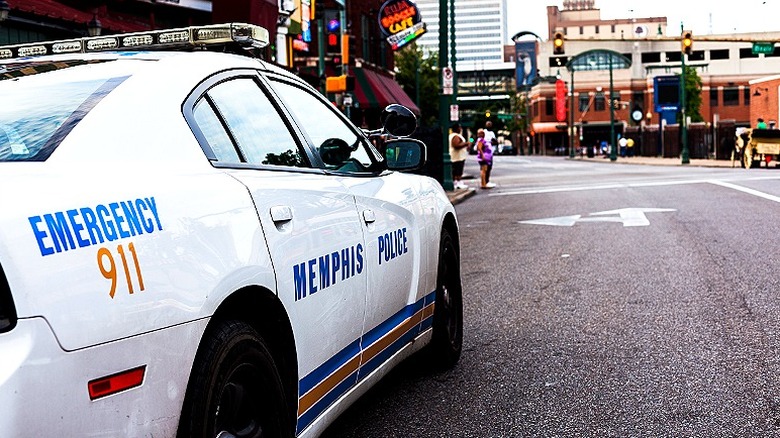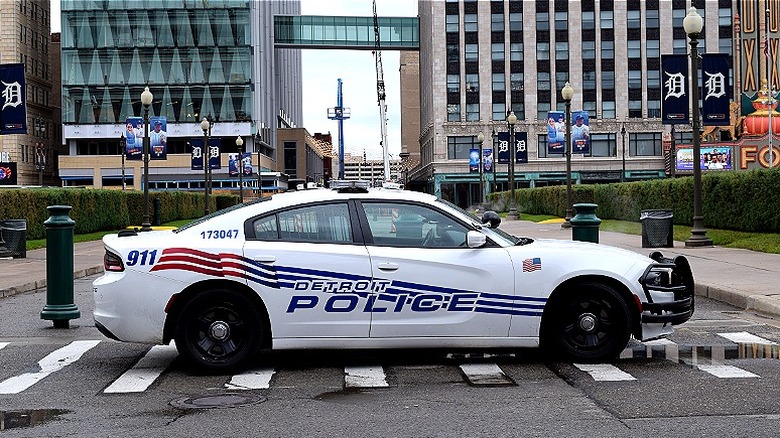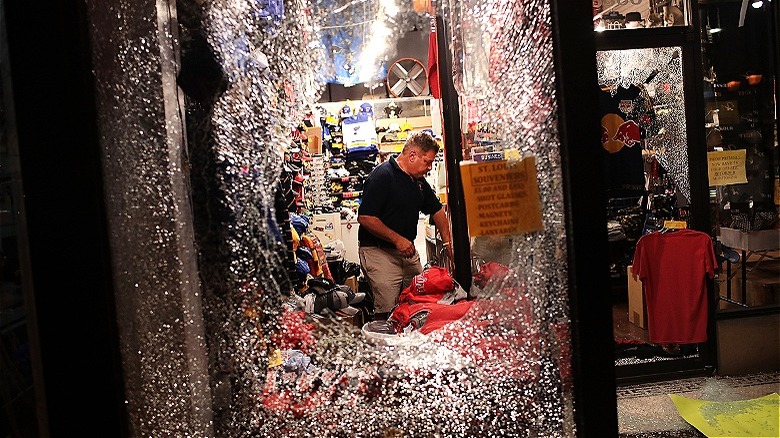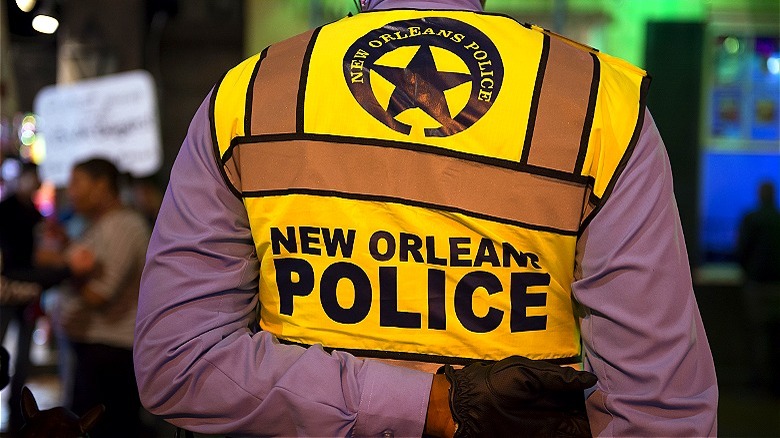The Cost Of Crime For Those Living In America's Most Dangerous Cities
When it comes to the cost of living in a city, safer doesn't necessarily mean cheaper. In heavily populated cities in the United States with populations of 100,000 or more, the cost of crime per capita (in 2022) was $2,221, according to MoneyGeek's annual analysis. In cities with over 300,000 people, meanwhile, that number grew to $3,325 per capita, or 74% higher than in smaller cities. It also turns out that the larger the city, the more likely it is to be on the dangerous side. While a generalization since there are large cities in the U.S. that aren't on any top 10 list of the most dangerous cities, there's a pattern where safety is concerned.
Crime costs several layers of government money for police departments, courts, corrections, and support for victims of crime. The stigma of high crime affects investment in both commercial and residential infrastructure, insurance rates, housing values, and even the earning potential of people living in these communities. Incarceration is also a drain on the economy. For example, in 2022, the cost of housing an inmate in a federal prison was $116.91 per day, per the Federal Bureau of Prisons, while the cost of a residential reentry center was $107.39 per day. In this article, we'll take a closer look at these costs, specifically for those living in five of the most dangerous U.S. cities.
Memphis, Tennessee
Memphis, Tennessee, according to MoneyGeek, is the fifth-most dangerous city in the U.S., and considering there were 397 homicides reported in 2023, it's well earned. The University of Memphis studied poverty in Memphis, Tennessee, and found the average rate of poverty was 21.4%, placing over a fifth of the population below the poverty line. Poverty in Memphis represents a much higher ratio than the national poverty rate of 13%. In 2024, the high levels of crime in Memphis have led to $1.9 million in federal funding for surveillance cameras in high crime areas for law enforcement. These cameras are in addition to the Memphis police department budget, which cost the city $275.7 million in 2022, roughly 39% of the city's annual budget, and grew to $284.75 million in 2023.
The city's Crime Prevention Through Environmental Design initiative will invest $1 million over the next four years into small business grants to create safety through better design that deters crime. The financial burden carried by each citizen of Memphis amounts to $9,056 per year.
Detroit, Michigan
Detroit, Michigan, was once a thriving industrial city. The home of the big three auto companies — General Motors, Chevrolet, and Ford — made it a place for middle-class wage earners in the U.S. to live out the American dream. That is, until more fuel-efficient foreign competitors from Europe and Japan arrived on American shores. Instead of pivoting to compete, the heads of these companies made the fatal decision to move work outside the city to take advantage of non-unionized labor.
Lower wages combined with economic headwinds led to depopulation in Detroit. The NAFTA agreement led to nearly 300,000 lost jobs in Detroit's auto sector between 2000 and 2017. The Great Recession of 2008 led to one-third of Detroit's homeowners losing their homes to foreclosure after falling behind on property taxes. Then, on July 18, 2013, Detroit became the biggest U.S. city to declare bankruptcy.
All of these factors became the catalyst for a 63% drop in population by 2015 and a violent crime rate represented by 2,056.67 violent felonies for every 100,000 Detroiters in 2019. As the fourth- most dangerous city in America, the cost of crime sits at $9,281, more than 10 times the fourth-safest large city, Honolulu, Hawaii, which is $832 per capita, according to MoneyGeek. Although the city of Detroit has its issues, other places in Michigan make it one of the best states to retire in the U.S.
St. Louis, Missouri
St. Louis, Missouri, reported 2,082.29 violent crimes per 100,000 people in 2019, with 194 of those crimes represented as homicides. Gun violence spurred on by access to illegal firearms and listless youth tend to be the accepted reason for high crime. Missouri boasts some of the laxest gun laws in the country, where gun ownership comes with no background checks or restrictions on the state level. In 2022, 20.4%, or a fifth of the population of St. Louis was living below the poverty line. Much like Detroit, the deindustrialization of St. Louis and the marginalization of racialized communities led to an economic downturn that St. Louis is still trying to come out of.
One initiative attempting to address the most serious financial challenges faced by families in St. Louis is a $500 basic income program for 18 months to benefit 540 families. That's the equivalent of $4.86 million in funding. In this third-most-dangerous city in America, according to MoneyGeek, crime costs St. Louis $11,055 per person every year. In comparison to the third-safest-city in the United States — Virginia Beach, Virginia — that's a difference of $10,282.
New Orleans, Louisiana
Although homicides in New Orleans dropped by 25% in 2023, that still meant 193 homicides in the same year, with 27 of those being people under the age of 18. Currently in 2024, murders were down further to 40%. A series of tough-on-crime measures focused on communities victimized by high crime communities are being lauded for the change.
According to Money Inc., the rate of violent crime in New Orleans' Pines Village is 591% higher than the national average, with a violent crime rate of 2,600 per 100,000, a property crime rate of 7400 per 100,000, and a total crime rate of 9,900 per 100,000 people in a neighborhood of just 4,140 people. Although no longer the dubious title holder of the "murder capital" of the nation, there is still a lot of room for improvement. Police officers make less money than you think, and it probably doesn't help that Louisiana is one of five states offering the lowest salary to police officers in the country.
For those living in New Orleans, the second-most-dangerous city in the United States, according to MoneyGeek, the cost of crime is $11,094 per person.
Birmingham, Alabama
In its analysis of FBI crime statistics of 302 cities in America, MoneyGeek found that Birmingham, Alabama, was the most dangerous city. Further, in this city, 25.5% of the population is identified as poor. This is more than twice the 12.6%, and is represented in higher numbers of women than men.
According to the National Institute for Criminal Justice Reform's economic breakdown across the city, county, and state, the total cost per homicide involving guns adds up to $805,000 per homicide, assuming there's just one suspect. For two suspects, that number climbs to $1.4 million. That number includes the costs associated with managing a crime scene, hospital intervention, the court system, incarceration, victim support, and lost taxes from both the victim's loss of life and the perpetrator's loss of freedom.
In a case of gun violence where the victim survives, it costs $598,000 with a single suspect or $1 million if there are two. Citizens in America's safest city, Thousand Oaks, California, spend $241 per capita, the lowest amount of any city in the country. On the other hand, the citizens of Birmingham are on the hook for $11,392 per capita, per MoneyGeek, in a city with one of the highest poverty rates in the nation.





